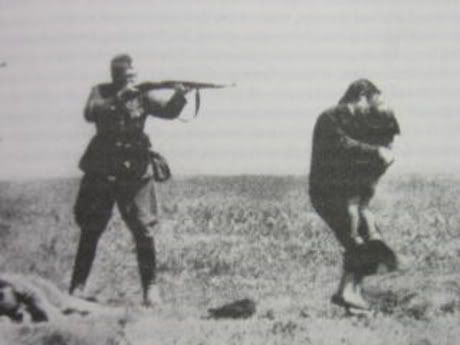(noon. – promoted by ek hornbeck)
Navajos at Big Mountain resisting forced relocation view the 19th Century prison camp of Bosque Redondo and the war in Iraq as a continuum of U.S. government sponsored terror. Louise Benally of Big Mountain remembered her great-grandfather and other Navajos driven from their beloved homeland by the U.S. Army on foot for hundreds of miles while witnessing the murder, rape and starvation of their family and friends.
“I think these poor children had gone through so much, but, yet they had the will to go on and live their lives. If it weren’t for that, we wouldn’t be here today.
– snip –
“The U.S. military first murders your people and destroys your way of life while stealing your culture, then forces you to learn their evil ways of lying and cheating,” Benally said.
And of course per history repeating…
Crossposted At Native American Netroots
“I feel that in relocating these elderly people, we are as bad as the Nazis that ran the concentration camps in World War II.”
Roger Lewis, federally appointed Relocation Commissioner upon resignation
U.S. Government Continues Genocidal Assault on the People of Black Mesa By Klee BenallyBlack Mesa, AZ — On Monday, December 22nd, 2008 The U.S. Department of the Interior Office of Surface Mining Reclamation and Enforcement (OSM) issued a decision to approve the Black Mesa Project. This decision continues the legacy of the United States Government’s genocidal policies against those living in the Black Mesa region.
(Video from July of 2005)
Looking for the deeper underling issue, while mentioning w using his last days in office to make last minute appointments, I have an opinion as to why this and similar issues fly below the public radar.
Censored from the article, which I had titled: “Pandering to corporations” in 2004
Bahe Katenay is responding to the fact that the Bush administration developed a task force to facilitate industry requests and fast track requests for drilling. The Bureau of Land Management increased oil and gas drilling permits by 70 percent since the previous administration.
Why would something like this have flown below the public radar, which is repeating today?
(Internet article no longer up)
…Jets fly low over the area on an almost daily basis, livestock is impounded by the Bureau of Indian Affairs on the pretense that resisters are “overgrazing” the land, and, due to the special Bennet Freeze clause of P.L.93-531 (which foresaw the possibility of a resistance) Dine people living on what is now Hopi Partitioned Land cannot legally upgrade their housing (i.e. repair a hole in their roof during the winter) without facing the threat of arrest because they no longer legally own the property their families have lived on for centuries. This type of regular harassment has been described as “low intensity psychological warfare” and it has become commonplace against families resisting relocation at Big Mountain.
These families continue to hope that public outcry will become so loud that Congress will no longer be able to ignore the damage which is done every day to people affected by relocation policies. In order to truly respect Native American self-determination, Congress must submit a full repeal of P.L.93-531 and use the money allocated for “relocation benefits” to repair the damage done to those people who have already been relocated (many of whom have yet to receive alternative housing). And while Congress remains reluctant to repeal…
Mel Brooks in “The Producers,” I believe, points to a psychological reason why something like this flies below the public radar. That is, that while people know better, all it takes to make some people laugh at genocide is to dress up a butcher/exterminator/dictator and then add humor. Then, the general public will engage in genocide denial by laughing and forgetting.
Here Mel Brooks is, doing us a great service as the great artist he is, as Hitler himself.
That’s so funny I forgot to laugh.


One chooses what they want to acknowledge, but then they may be choosing the behavior of individuals they don’t really want to emulate.
“Springtime for Hilter?” Indeed it is Mel, indeed it is on a global level. All we need to start change and transformation is for our representatives and so on in key areas to lose a few nights good sleep. Hellish dreams and sad tears.
“I feel that in relocating these elderly people, we are as bad as the Nazis that ran the concentration camps in World War II.”
Roger Lewis, federally appointed Relocation Commissioner upon resignation
In 1974, the mining industry played a major role in passage of the Navajo-Hopi Settlement Act of 1974. This crucial piece of legislation resulted in the largest relocation of Native American people since the 1860’s. The relocation effort has been a disaster. More than 12,000 people have been relocated over the past 22 years. Some were sent to cities where, unable to speak English or relate to a non-traditional economy, they quickly lost the small sums of money they were given at the time of the relocation. The rest were sent to the “New Lands”, an Environmental Protection Agency (EPA) Superfund site contaminated by the nation’s worst nuclear spill. But many families resisted orders to relocate, and 23 years later, several thousand still remain on their traditional homesites. This relocation has cost the U.S. taxpayers over $350 million.
The people affected by the legislation were never directly informed of its adoption, never allowed to testify in any Congressional hearing and never allowed to be represented in any way through the process. All the decisions that led to partition of their land were carried out and enacted by newly created male-dominated tribal councils located 100 miles away from the directly affected people.
Navajo Uranium Radiation Victims
The meeting was conducted almost entirely in the Navajo language. In addition to testimony from surviving miners, there were also presentations by the Navajo Nation’s Abandoned Minelands Reclamation Project and also the tribe’s Office of Navajo Uranium Workers. They were attempting to deal with the aftermath of uranium mining in the area, including identifying hundreds of mining sites in the area, compiling a registry of all tribal mine and mill workers, assisting with the complicated claims process for compensation, and improving health services for the many sick and injured people.
At first, it was a mystery as to why there was so much lung disease in the community, but by now it is understood that, as one of the widows stated, the miners, their husbands, died because the uranium ate up their lungs.
Navajo Nation endures water crisisShaun McKinnon
The Arizona Republic
Aug. 26, 2007 12:00 AMTONALEA – Ethel Whitehair ran out of water again over the weekend, emptied every bucket and pot, drained the barrels lined up outside her front door. The community well was closed until Monday.
Water from a well at a nearby windmill could supply the sheep, but it was untreated and made Whitehair’s skin itch. At another windmill down the road, vandals had torn the cover off the storage tank. Deep inside, a car battery steeped in the soupy dregs, the surface stirred by the bloated bodies of three dead crows.
N.M. Senators: Bill to Settle Navajo Nation Water Rights Claim Moves Forward
WASHINGTON – U.S. Senator Jeff Bingaman and Pete Domenici today reported that legislation they wrote to settle the Navajo Nation’s water rights claims in the San Juan River Basin has cleared its first hurdle. With today’s approval by the Senate Energy and Natural Resources Committee, the measure can now be considered by the full Senate.
Bingaman reintroduces Navajo water billCopyright © 2009
Gallup Independent
By Diné Bureau“It is shameful that 70,000 people on the Navajo Nation, located in the wealthiest nation on earth, do not have easy access to water, one of the most basic necessities of life,” Udall said. “This legislation will help eliminate this injustice while resolving conflict over water rights and ensuring that the city of Gallup will also have better access to water.
To conclude, it’s springtime for one of Hitler’s greatest inspirations, and when Christendom and American genocidal colonialism went to Germany – it was wrapped in a Swastika.
“The swastika was a widely used Native American symbol. It was used by many southwestern tribes, most notably the Navajo. Among different tribes the swastika carried various meanings. To the Hopi it represented the wandering Hopi clans; to the Navajo it represented a whirling log ( tsil no’oli’ ), a sacred image representing a legend that was used in healing rituals.”
Please add Brenda Norrell’s blog to your blog listings or favorites, she needs our support.


5 comments
Skip to comment form
Author
Author